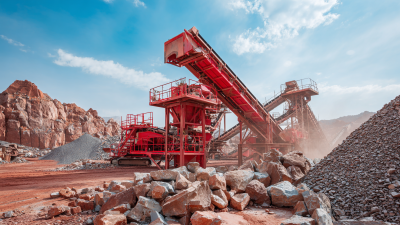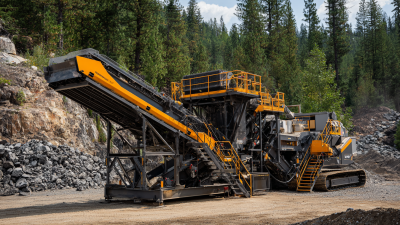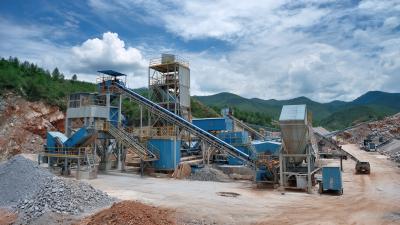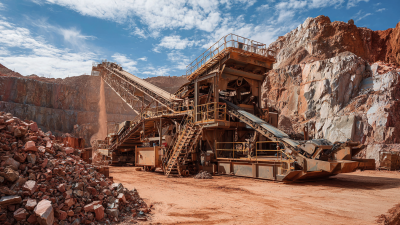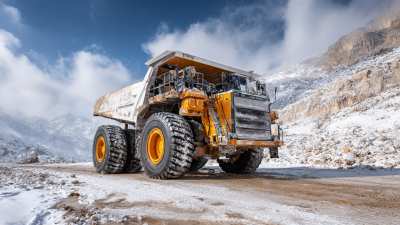The construction industry continues to evolve, driven by technological advancements and a growing demand for infrastructure development across the globe. Among the critical components of this transformation is the Stone Crusher Machine, which plays a pivotal role in the processing of aggregates for various construction projects. According to a recent report by Grand View Research, the global stone crushing equipment market was valued at approximately $4.3 billion in 2022 and is expected to expand at a compound annual growth rate (CAGR) of 3.4% from 2023 to 2030. This growth underscores the increasing importance of stone crusher machines in meeting the rising demands for high-quality construction materials, essential for urbanization and infrastructure resilience. As cities expand and infrastructure demands increase, the efficiency and innovations brought by stone crusher machines become indispensable, marking their essential role in revolutionizing construction methodologies and practices.

The evolution of stone crusher machines has significantly transformed the construction industry over the years. Initially, these machines were rudimentary, relying on manual labor and basic tools for crushing stones. As the demand for more efficient and precise stone processing grew, advancements in technology led to the development of mechanized crushers. Early innovations included the introduction of swing hammers and jaw crushers, which allowed for the efficient breaking of large boulders into smaller, more manageable sizes.
In recent decades, stone crusher machines have undergone substantial enhancements, characterized by increased automation and improved design. Modern crushers now utilize hydraulic systems and advanced control mechanisms, resulting in higher efficiency and reduced operational costs. Additionally, the integration of eco-friendly technologies has become a focus, leading to machines that not only maximize productivity but also minimize environmental impact. This evolution not only streamlines construction processes but also supports sustainable practices within the industry, highlighting the essential role of stone crusher machines in shaping modern infrastructure.
| Type of Stone Crusher | Capacity (tons/hour) | Power Requirement (kW) | Applications | Year Introduced |
|---|---|---|---|---|
| Jaw Crusher | 100-200 | 75-150 | Primary crushing in quarries, recycling | 1830s |
| Cone Crusher | 50-150 | 75-200 | Secondary and tertiary crushing | 1920s |
| Impact Crusher | 30-400 | 60-500 | Concrete recycling, aggregate production | 1960s |
| Mobile Crusher | 100-500 | 50-300 | On-site crushing, demolition | 2000s |
In the construction industry, stone crusher machines have become indispensable tools that significantly enhance the efficiency and effectiveness of modern infrastructure projects. According to a report by ResearchAndMarkets, the global stone crushing equipment market is expected to reach USD 8.9 billion by 2025, growing at a compound annual growth rate (CAGR) of 9.2%. This surge is largely driven by the increasing demand for construction aggregates in urban development and infrastructure initiatives across the globe.

One of the primary benefits of using stone crushers is their ability to produce high-quality aggregates tailored to specific construction needs. For instance, crushed stone is essential for creating durable concrete, and better quality aggregates lead to stronger and more resilient structures. Additionally, operating stone crushers can significantly reduce construction costs. A study by the National Stone, Sand and Gravel Association highlighted that stone crushing operations can lower transportation expenses by producing materials closer to the job site, thereby optimizing supply chain logistics.
Moreover, the integration of advanced technologies in stone crushers improves their efficiency and sustainability. Modern machines are equipped with features that minimize energy consumption and reduce environmental impact through lower emissions. The use of stone crushers aligns with the industry's push towards greener construction practices, as highlighted in the Global Green Building Trends report, which indicates a rising preference for sustainable construction materials. As infrastructure projects evolve, the role of stone crusher machines will be crucial in meeting the challenges of modern construction demands.
Innovative technologies in stone crushing equipment are transforming the construction industry, enhancing efficiency and sustainability. According to a report by Research and Markets, the global stone crushing equipment market is projected to reach $4.6 billion by 2026, growing at a CAGR of 3.1% from 2021. The integration of smart technology in stone crushers, such as automation and remote monitoring, is significantly improving operational efficiency. For instance, equipment with IoT capabilities can monitor performance in real time, reducing downtime and optimizing resource use.

Moreover, advancements in machinery design, such as the introduction of mobile crushers, are revolutionizing how materials are processed on-site. The flexibility to move equipment directly to the extraction site minimizes transportation costs and reduces emissions. A study published by Future Market Insights highlights that mobile crushing and screening equipment is expected to witness a growth rate of 4.5% during the next five years.
These innovative solutions not only enhance productivity but also align with the industry's shift towards sustainable construction practices, making stone crusher machines a cornerstone of modern infrastructure development.
The stone crushing industry plays a crucial role in infrastructure development, but with this comes significant environmental responsibility. Recent orders from the Supreme Court of Khyber-Pakhtunkhwa to enforce stone crushing regulations highlight the urgent need for sustainable practices within this sector. Compliance with environmental norms is essential to mitigate the adverse effects of stone crushing operations, which often include dust pollution and habitat destruction. The implementation of strict regulations can promote cleaner production techniques and ensure that companies take proactive steps towards sustainability.
Innovative approaches are already being explored in various regions to enhance operational efficiency and reduce environmental impact, as demonstrated by a recent study in Ethiopia on limestone quarrying. The integration of mobile crushers has also gained traction in markets like South Korea, allowing for effective stone processing on-site, thereby minimizing transportation emissions. Such advancements not only support the demand for construction materials but also align with global sustainability goals, paving the way for a more environmentally friendly approach to infrastructure development in the stone crushing industry.
This chart illustrates the impact of stone crusher machines on different dimensions of sustainability in construction practices. The data showcases energy consumption, recycling rates, and waste production in stone crushing operations.
When selecting the right stone crusher for your construction needs, it's crucial to assess the specific requirements of your project. Different types of stone crushers vary in functionality, from jaw crushers designed for primary crushing to cone crushers suitable for secondary stages. Understanding the size and type of material you’ll be working with will help you determine the most suitable machine. Factors such as the required output size, the hardness of the material, and the desired production capacity should guide your choice.
Another important consideration is the machine's efficiency and operating costs. Look for crushers that offer high productivity while minimizing energy consumption. Many modern stone crushers come equipped with advanced technology that enhances their performance, such as automated control systems and ease of maintenance features. Additionally, evaluating the reputation and support of the manufacturer can provide insights into the reliability and longevity of the equipment, ensuring that your investment serves you well in the long run.
